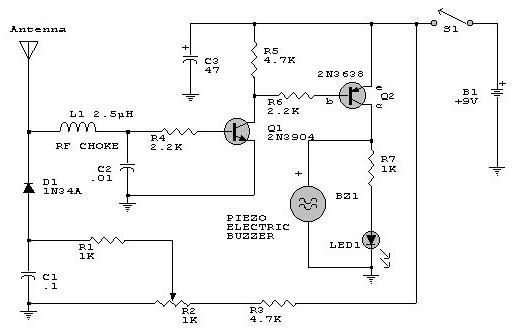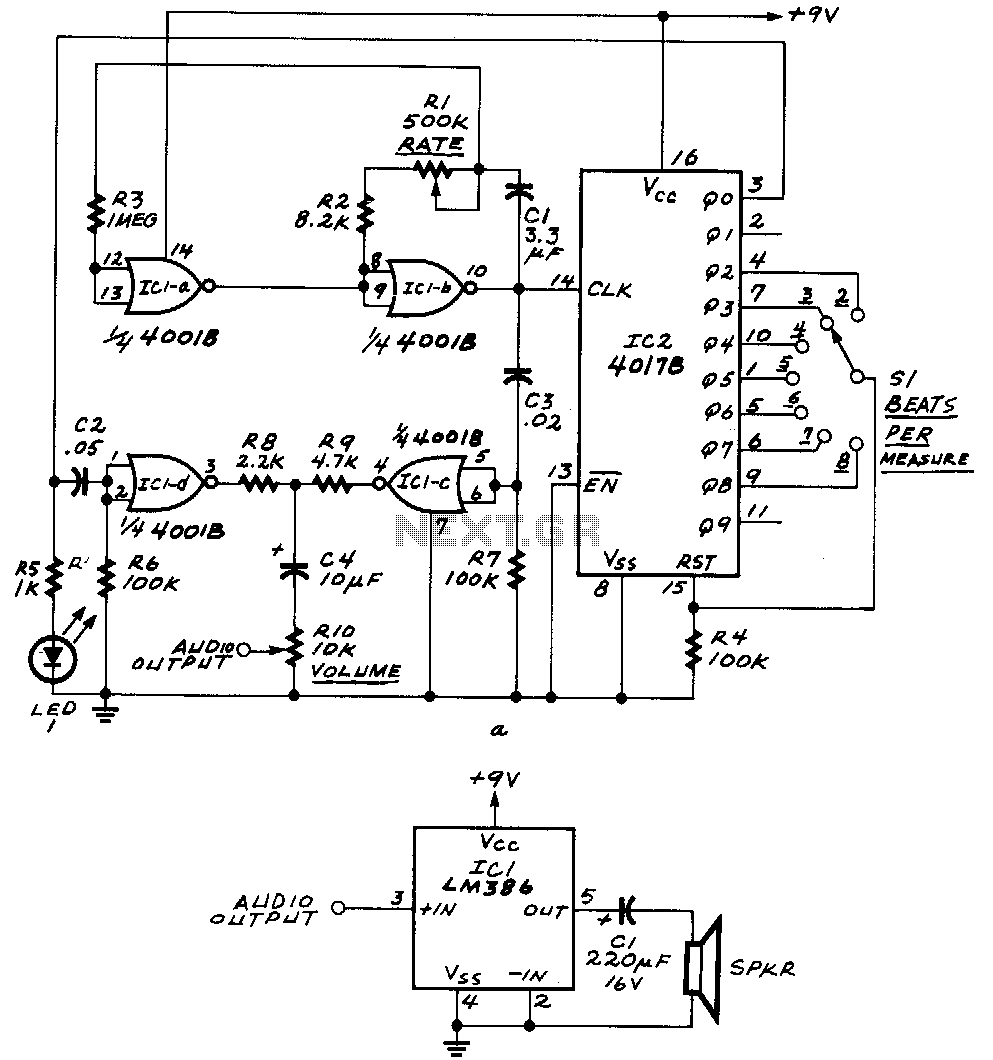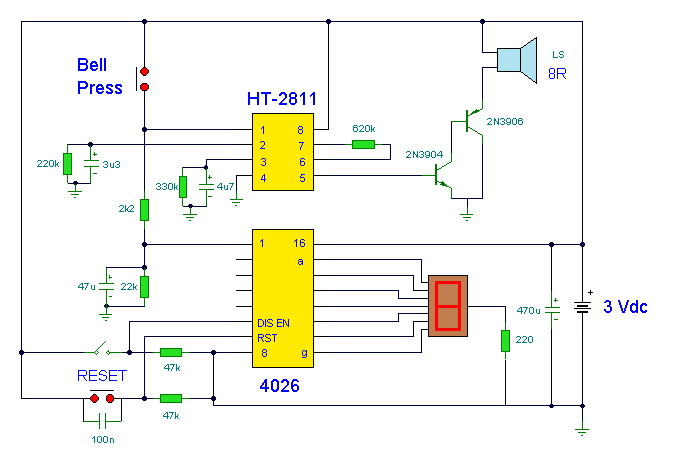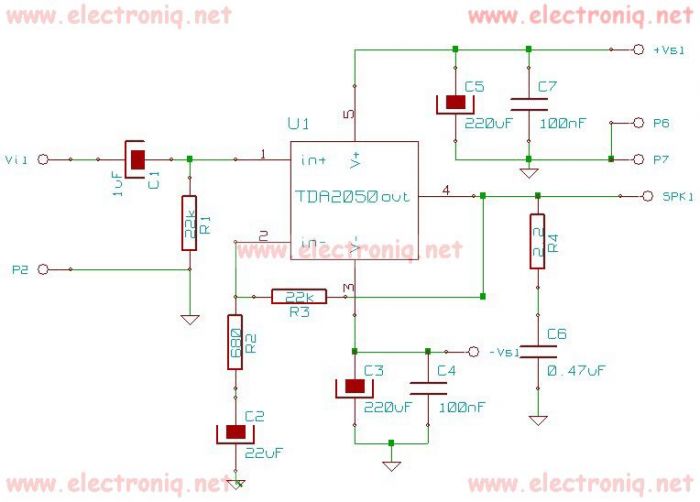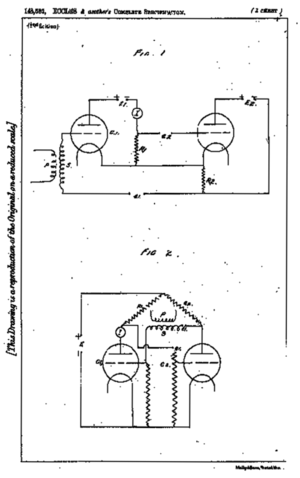
Electronic Dice
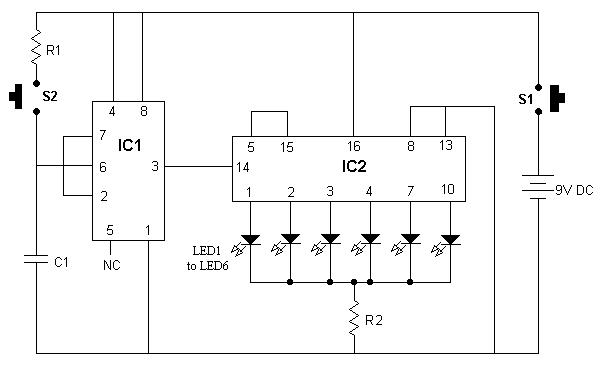
It is advisable to place this circuit in a box and label each LED with numbers 1 to 6. When switch S1 is pressed momentarily, one of the six LEDs will illuminate, and the number associated with the glowing LED represents the output of the dice. Each time S1 is released, a different LED will light up randomly, with each LED having a 16.66% chance of glowing. This circuit utilizes two integrated circuits (ICs): IC555 and IC-CD4017. The IC555 functions as a square wave generator, while the IC-CD4017 operates as a counter. Specifically, the CD4017 is a divide-by-10 Johnson counter with 10 decoded outputs. The IC555 generates a clock signal for the CD4017, with the clock frequency determined by resistors R1 and capacitor C1. The CD4017 counter begins counting from 0 to 9, activating each of the 10 output pins sequentially with a high voltage. The high voltage shifts from one pin to the next on each positive edge of the clock signal. In this circuit, pin 5 is connected to pin 15 (reset), causing the counter to reset after reaching 6 and start again from 0. When S1 is pressed, the IC555 generates a clock for the CD4017, allowing it to count from 0 to 6, lighting up each of the six connected LEDs in sequence. Upon releasing S1, the high voltage is latched to one of the six pins, which becomes the output of the dice.
The circuit design effectively simulates a dice roll using basic electronic components. The IC555 is configured in astable mode, generating a continuous square wave that serves as a clock signal for the CD4017. The frequency of the clock is adjustable through R1 and C1, allowing for customization of the speed at which the LEDs cycle. The CD4017's output pins are connected to the LEDs, which are typically arranged in a visually appealing manner on the enclosure.
When S1 is activated, the clock signal enables the CD4017 to sequentially activate the outputs corresponding to the LEDs. The reset function, achieved by connecting pin 5 to pin 15, ensures that the counter only counts to 6, aligning with the six faces of a standard die. The random selection of an LED upon releasing the switch is a result of the latching mechanism, which maintains the last activated output until the next press of S1.
This circuit not only serves as a fun electronic project but also provides a practical application of digital counting and LED control, making it an excellent educational tool for understanding basic electronics and digital logic. Proper assembly and labeling enhance usability, ensuring that users can easily interpret the output as a dice roll.It is good idea to put this circuit in a box and mark/write each LED with number 1 to 6. Now, when switch S1 is pushed momentarily, any one of the 6 LEDs will glow. The Number marked for glowing LED becomes dice`s output. Every time S1 is released, new LED will glow randomly. Chances for each LED to glow is 16. 66%. This circuit makes use of two IC s, IC555 and IC-CD4017. IC-555 is used as square wave generator, and IC(CD4017) as a counter. Actually CD4017 is a divide-by-10 johnson-counter with 10 decoded outputs. IC555 simply generates clock for CD4017, and the clock frequency is controlled by R1 and C1. Counter CD4017 starts counting from 0 to 9 by putting high voltage on each of the 10 pins (one after another). The High voltage shifts from one pin to another on every positive edge of the clock. Since, in our circuit pin-5 is shorted with pin-15(reset), the counter gets reset after reaching 6, and again starts from 0.
Now, when S1 is pushed, IC555 generates clock for CD4017. This clock enables CD4017 to count from 0 to 6 by putting high voltage on each of the 6 pins (one after another). These 6 pins are connected to 6 respective LEDs. When S1 is released, high voltage gets latched to any one of the 6 pins, and this becomes output of the DICE.
All the material on this website is copyright property of Material on this site is for personal use only and can not be used for any commercial activity without written permission of Use the information provided within this website at your own risk. Information within this website is provided as-is without warranty or guarantee of any kind. Please read Copyright and Disclaimer notice carefully. 🔗 External reference
The circuit design effectively simulates a dice roll using basic electronic components. The IC555 is configured in astable mode, generating a continuous square wave that serves as a clock signal for the CD4017. The frequency of the clock is adjustable through R1 and C1, allowing for customization of the speed at which the LEDs cycle. The CD4017's output pins are connected to the LEDs, which are typically arranged in a visually appealing manner on the enclosure.
When S1 is activated, the clock signal enables the CD4017 to sequentially activate the outputs corresponding to the LEDs. The reset function, achieved by connecting pin 5 to pin 15, ensures that the counter only counts to 6, aligning with the six faces of a standard die. The random selection of an LED upon releasing the switch is a result of the latching mechanism, which maintains the last activated output until the next press of S1.
This circuit not only serves as a fun electronic project but also provides a practical application of digital counting and LED control, making it an excellent educational tool for understanding basic electronics and digital logic. Proper assembly and labeling enhance usability, ensuring that users can easily interpret the output as a dice roll.It is good idea to put this circuit in a box and mark/write each LED with number 1 to 6. Now, when switch S1 is pushed momentarily, any one of the 6 LEDs will glow. The Number marked for glowing LED becomes dice`s output. Every time S1 is released, new LED will glow randomly. Chances for each LED to glow is 16. 66%. This circuit makes use of two IC s, IC555 and IC-CD4017. IC-555 is used as square wave generator, and IC(CD4017) as a counter. Actually CD4017 is a divide-by-10 johnson-counter with 10 decoded outputs. IC555 simply generates clock for CD4017, and the clock frequency is controlled by R1 and C1. Counter CD4017 starts counting from 0 to 9 by putting high voltage on each of the 10 pins (one after another). The High voltage shifts from one pin to another on every positive edge of the clock. Since, in our circuit pin-5 is shorted with pin-15(reset), the counter gets reset after reaching 6, and again starts from 0.
Now, when S1 is pushed, IC555 generates clock for CD4017. This clock enables CD4017 to count from 0 to 6 by putting high voltage on each of the 6 pins (one after another). These 6 pins are connected to 6 respective LEDs. When S1 is released, high voltage gets latched to any one of the 6 pins, and this becomes output of the DICE.
All the material on this website is copyright property of Material on this site is for personal use only and can not be used for any commercial activity without written permission of Use the information provided within this website at your own risk. Information within this website is provided as-is without warranty or guarantee of any kind. Please read Copyright and Disclaimer notice carefully. 🔗 External reference
